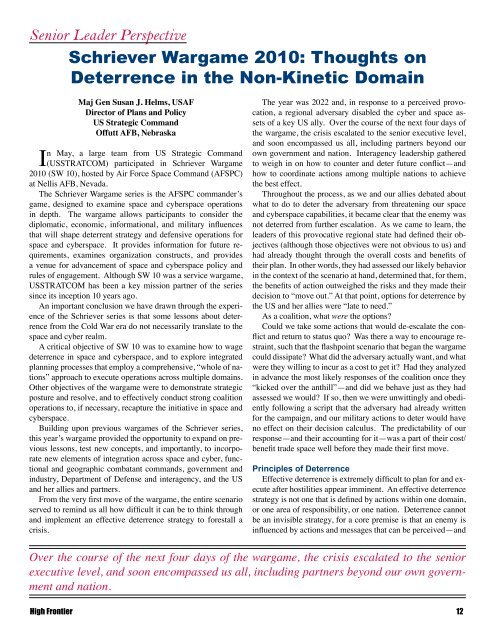Schriever Wargame 2010 - Air Force Space Command
Schriever Wargame 2010 - Air Force Space Command
Schriever Wargame 2010 - Air Force Space Command
Create successful ePaper yourself
Turn your PDF publications into a flip-book with our unique Google optimized e-Paper software.
Senior Leader Perspective<br />
<strong>Schriever</strong> <strong>Wargame</strong> <strong>2010</strong>: Thoughts on<br />
Deterrence in the Non-Kinetic Domain<br />
Maj Gen Susan J. Helms, USAF<br />
Director of Plans and Policy<br />
US Strategic <strong>Command</strong><br />
Offutt AFB, Nebraska<br />
In May, a large team from US Strategic <strong>Command</strong><br />
(USSTRATCOM) participated in <strong>Schriever</strong> <strong>Wargame</strong><br />
<strong>2010</strong> (SW 10), hosted by <strong>Air</strong> <strong>Force</strong> <strong>Space</strong> <strong>Command</strong> (AFSPC)<br />
at Nellis AFB, Nevada.<br />
The <strong>Schriever</strong> <strong>Wargame</strong> series is the AFSPC commander’s<br />
game, designed to examine space and cyberspace operations<br />
in depth. The wargame allows participants to consider the<br />
diplomatic, economic, informational, and military influences<br />
that will shape deterrent strategy and defensive operations for<br />
space and cyberspace. It provides information for future requirements,<br />
examines organization constructs, and provides<br />
a venue for advancement of space and cyberspace policy and<br />
rules of engagement. Although SW 10 was a service wargame,<br />
USSTRATCOM has been a key mission partner of the series<br />
since its inception 10 years ago.<br />
An important conclusion we have drawn through the experience<br />
of the <strong>Schriever</strong> series is that some lessons about deterrence<br />
from the Cold War era do not necessarily translate to the<br />
space and cyber realm.<br />
A critical objective of SW 10 was to examine how to wage<br />
deterrence in space and cyberspace, and to explore integrated<br />
planning processes that employ a comprehensive, “whole of nations”<br />
approach to execute operations across multiple domains.<br />
Other objectives of the wargame were to demonstrate strategic<br />
posture and resolve, and to effectively conduct strong coalition<br />
operations to, if necessary, recapture the initiative in space and<br />
cyberspace.<br />
Building upon previous wargames of the <strong>Schriever</strong> series,<br />
this year’s wargame provided the opportunity to expand on previous<br />
lessons, test new concepts, and importantly, to incorporate<br />
new elements of integration across space and cyber, functional<br />
and geographic combatant commands, government and<br />
industry, Department of Defense and interagency, and the US<br />
and her allies and partners.<br />
From the very first move of the wargame, the entire scenario<br />
served to remind us all how difficult it can be to think through<br />
and implement an effective deterrence strategy to forestall a<br />
crisis.<br />
The year was 2022 and, in response to a perceived provocation,<br />
a regional adversary disabled the cyber and space assets<br />
of a key US ally. Over the course of the next four days of<br />
the wargame, the crisis escalated to the senior executive level,<br />
and soon encompassed us all, including partners beyond our<br />
own government and nation. Interagency leadership gathered<br />
to weigh in on how to counter and deter future conflict—and<br />
how to coordinate actions among multiple nations to achieve<br />
the best effect.<br />
Throughout the process, as we and our allies debated about<br />
what to do to deter the adversary from threatening our space<br />
and cyberspace capabilities, it became clear that the enemy was<br />
not deterred from further escalation. As we came to learn, the<br />
leaders of this provocative regional state had defined their objectives<br />
(although those objectives were not obvious to us) and<br />
had already thought through the overall costs and benefits of<br />
their plan. In other words, they had assessed our likely behavior<br />
in the context of the scenario at hand, determined that, for them,<br />
the benefits of action outweighed the risks and they made their<br />
decision to “move out.” At that point, options for deterrence by<br />
the US and her allies were “late to need.”<br />
As a coalition, what were the options?<br />
Could we take some actions that would de-escalate the conflict<br />
and return to status quo? Was there a way to encourage restraint,<br />
such that the flashpoint scenario that began the wargame<br />
could dissipate? What did the adversary actually want, and what<br />
were they willing to incur as a cost to get it? Had they analyzed<br />
in advance the most likely responses of the coalition once they<br />
“kicked over the anthill”—and did we behave just as they had<br />
assessed we would? If so, then we were unwittingly and obediently<br />
following a script that the adversary had already written<br />
for the campaign, and our military actions to deter would have<br />
no effect on their decision calculus. The predictability of our<br />
response—and their accounting for it—was a part of their cost/<br />
benefit trade space well before they made their first move.<br />
Principles of Deterrence<br />
Effective deterrence is extremely difficult to plan for and execute<br />
after hostilities appear imminent. An effective deterrence<br />
strategy is not one that is defined by actions within one domain,<br />
or one area of responsibility, or one nation. Deterrence cannot<br />
be an invisible strategy, for a core premise is that an enemy is<br />
influenced by actions and messages that can be perceived—and<br />
Over the course of the next four days of the wargame, the crisis escalated to the senior<br />
executive level, and soon encompassed us all, including partners beyond our own government<br />
and nation.<br />
High Frontier 12

















